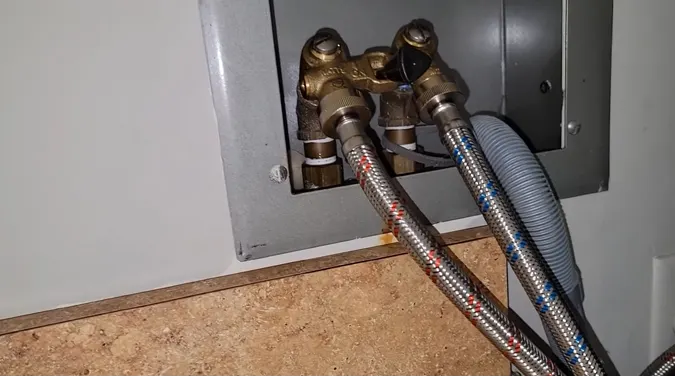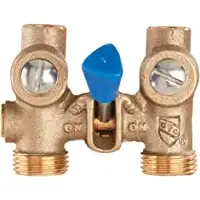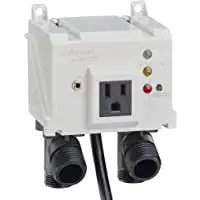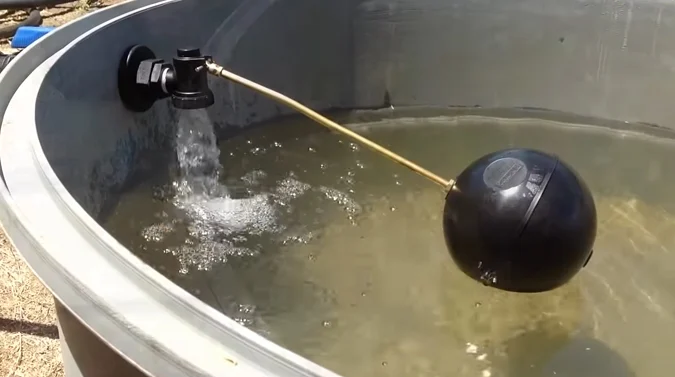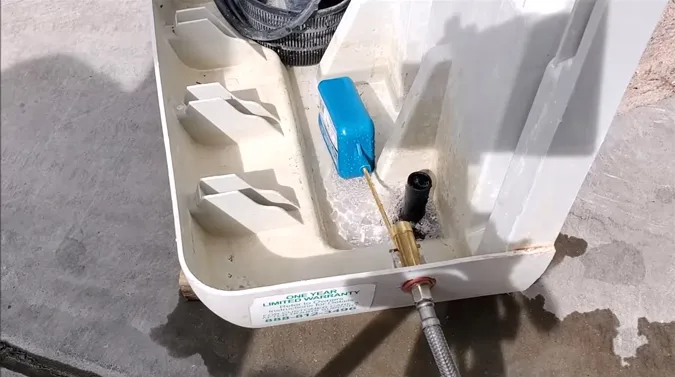Last Updated on May 17, 2023
It’s possible for the water shut-off valve parts to corrode or damage over time, leading to leaks or failures. It is possible that the floor or the surrounding area will flood in this scenario. The best washing machine shut off valve can help prevent these problems by ensuring that water flow is properly controlled.
There is usually a brass or bronze valve on the back of the washing machine. And the valve is not corrosion-damaged or worn out after a long time of use. You can choose between automatic and manual. Plus, there are different designs to choose from.
Below, you’ll find our recommendations for the top five washing machine shut-off valves for your needs. You also find here a buyer’s guide with all the information you need to know about these valves.

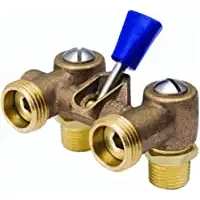
Mueller B & K Brass Water Shut Off Valve Fitted to Washing Machine
● Material: Brass
● Operation Mood: Manual
● Item Dimensions L x W x H: 4 x 3 x 3 inches
What Are the Different Types of Washing Machine Valves?

While automatic and manual are two main types, there are also different designs to consider regarding the washing machine shut-off valve. And the most common valves are ball, gate, and butterfly valves.
Ball valves have a ball-shaped mechanism that allows water to flow through when it’s in the open position and blocks the water when it’s in the closed position. These valves are durable and can withstand high water pressure. They’re also easy to operate.
On the other hand, gate valves have a flat gate that lifts up or drops down to open or close the water flow. These valves are also durable but may not be able to handle high water pressure as well as ball valves. They’re also a bit more difficult to operate.
Butterfly valves have a disc that opens or closes the water flow by rotating. These valves are less durable than ball and gate valves but are much easier to operate.
The following are two ball-type valves that are the most common:
1. Mueller B & K Brass Water Shut Off Valve Fitted to Washing Machine

Mueller B & K brass water shut off valve fitted to washing machines is sturdy and reliable. It features a ball valve design that allows for easy shut-off of the water flow, and it’s heavy brass construction ensures strength and durability.
The hose threads on the outlet side comply with ANSI B1.20.7, making it easy to connect a standard garden hose. This valve is an essential part of any washing machine, and its high quality makes it a great choice for long-term use.
How Can This Product Help You?
The Mueller B & K washing machine shut-off valve is a vital piece of equipment for any home, as it helps to prevent water damage in the event of a leak. This particular valve can be installed on both hot and cold water lines.
It features all-brass construction for durability, and it comes with two stainless steel screws for mounting. This valve is also lead-free and meets all applicable standards for quality and safety.
Positive Aspects:
- Perfect replacement for an old, leaking valve
- Comes with new screws and washers
- Can be used with copper, or brass fittings
- Installation is quick and easy
- No need to call the plumber for fitting
Insufficiencies:
- Over-tightening screws can damage the valve’s inner components
2. Watts 175C Ball Type Shut Off Valve for Washing Machine

The Watts 175C ball type shut off valve for a washing machine is an easy-to-install, reliable option for shutting off water flow to your machine. This valve is made of bronze and features adapters for solder or hose connections, making it suitable for various applications.
It’s capable of handling 200 PSI and 200° F, making it ideal to be used for potable water and hydronic heating. The single lever on-off design makes it easy to control hot and cold water flow simultaneously.
How Can This Product Help You?
If you have a washing machine, it’s imperative to have a Watts washing machine shut off valve to protect your home in case of leaks. A washing machine that leaks can seriously damage your floors and walls, so it’s helpful to have a way to shut off the water supply quickly and easily.
The Watts 175C shut-off valve is easy to install and is an affordable way to prevent water damage. Plus, it’s simple, so you can quickly shut off the water supply if there is a leak.
Positive Aspects:
- Dependable shut-off valves that you can count on
- Quick connect fittings make installation a breeze
- Constructed from high-quality materials for durability
- Enhance water supply safety and efficiency in your home
- Don’t let harmful things get into your family
Insufficiencies:
- It can be tricky to retrofit Watts units with different pipe fittings
What Is the Best Washing Machine Automatic Shut Off Valve?

When it comes to choosing a quality automatic shutoff valve for your washing machine, you should keep certain things in mind. It could be helpful to look for a valve made of durable materials and a smart feature design, so it will be long-lasting and easy to use. You can check it:
➤ Watts 0004648 automatic washing machine shut off valve

The Watts 0004648 automatic washing machine shut off valve leak sensor is an excellent choice for those looking for an automated flood detection system. This valve features real-time text and email alerts in the event of a water leak, as well as a replaceable internal strainer screen.
It also has an optional A-2 IntelliTimer, which allows it to be used with 240 VAC-powered washing machines or combination washers/dryers. The maximum pressure setting is 150 psi, and the washing machine’s maximum current rating is 15A.
How Can This Product Help You?
If you have a washing machine at home, it’s important to protect your home from potential water damage by installing a Watts 0004648 shut-off valve. This valve shuts off the water supply immediately if the inlet hose bursts, and it continuously detects water behind a washing machine.
Plus, it’s WiFi-enabled so that you can receive real-time text and email alerts about any flooding. No electrical wiring is required. Using the Intelliflow, connect the washing machine to a standard 115V, 15A, GFI outlet.
Positive Aspects:
- The system shuts off the water if the inlet hose bursts
- Monitors for water presence continuously
- It is available with or without a wall box
- Sensor for electronic control devices
- Real-time text, and email alerts via WiFi
Insufficiencies:
- There’s no manual shut-off switch for emergencies
- Intelliflow must require a 115-volt outlet
What Is the Best Hydro Master Washing Machine Shut Off Valve?

HYDRO MASTER is a trusted brand regarding plumbing supplies, and their washing machine shut-off valve is no exception. Their 0004648 and 0610701 models are two of the most popular choices on the market. The followings are the specs for both:
➤ HYDRO MASTER 0004648 1/2 Inch NPT Water Shut Off Valve for Washing Machine

The HYDRO MASTER 0004648 1/2 inch NPT water shut off valve for washing machines is made of brass and is designed for strength and durability. It features a 1/2-inch MNPT (sweat) connection and a 3/4-inch outlet hose thread.
Its single-lever stainless steel on/off switch is compatible with hot/cold water and can be used with most USA washing machines. Installation is easy, and the valve can be used to shut off the washing machine’s water supply.
How Can This Product Help You?
A shut-off valve for a washing machine is a must-have for any home. This HYDRO MASTER 0004648 high-quality brass valve is easy to install and can be used with hot or cold water. It has a maximum pressure of 125 psi and a temperature rating of 180°F.
With this valve, you’ll never have to worry about your washing machine stopping up again. And it’s a great way to save water and energy, too.
Positive Aspects:
- High-quality brass construction
- On/off switch made of stainless steel
- Compatible with hot and cold water
- 180°F temperature rating
- 125 psi maximum pressure
Insufficiencies:
- Some users say the provided O rings are thin and dainty
➤ HYDRO MASTER 0610701 Washing Machine Stop Valves

HYDRO MASTER 0610701 washing machine stop valves feature two lead-free brass valves with water hammer arresters. These valves are easy to install and include a support bracket and a Snap-On faceplate cover to complete the installation.
The outlet box is designed for a center drain connection and has an NPSM inlet 1/2-inch in diameter and an MHT outlet 3/4-inch in diameter.
How Can This Product Help You?
Anyone who has ever had a washing machine overflow knows the importance of a quality washing machine shut-off valve. Installing one of these valves is an easy way to protect your home from water damage. The Hydro Master 0610701 shut-off valve is designed to do just that.
It can quickly cut off the water supply to your washing machine when it starts to overflow, preventing more water from entering your home. The valve is easy to install and operate and comes with built-in shock arrestors, so you don’t have to add them to the water lines.
Positive Aspects:
- Quality construction, easy to install
- Shock arrestors built-in for extra protection
- The water shutoff no longer makes a knocking sound
- Can be used to replace an old washer valve
Insufficiencies:
- Depending on your current setup, it might take a little extra work
The Best Washing Machine Shut Off Valves Overviews
| Product | Material | Operation Mood | Item Dimensions L x W x H |
| Mueller B & K | Brass | Manual | 4 x 3 x 3 inches |
| Watts 175C | Bronze | Manual | 3.9 x 3.7 x 2.8 inches |
| Watts 0004648 | Bronze | Automatic | 8.88 x 6.02 x 3.69 inches |
| HYDRO MASTER 0004648 | Brass | Manual | 4.37 x 3.19 x 0.71 inches |
| HYDRO MASTER 0610701 | Brass | Manual | 10.7 x 8.1 x 3.4 inches |
How to Choose the Best Washing Machine Shut Off Valve?

The above models are just a few of the many different types of washing machine shut-off valves available on the market. When choosing the best value for your home, there are a few things you’ll want to keep in mind for a manual valve.
1. Type of Water Connection
The three most common types of water connections are threaded, sweat, and compression.
A threaded connection is made by screwing the valve into the pipe, while a sweat connection is soldered onto the pipe. On the other hand, a compression connection uses a nut and ferrule to secure the valve in place.
To determine the type of connection on your existing shut-off valve, simply look at how it’s attached to the pipe. If it’s screwed on, you have a threaded connection. You have a sweat connection if it’s soldered on. And if it uses a nut and ferrule, you have a compression connection.
2. Valve Size
There are two ways to measure the valve size needed for a washing machine: (1) With the old valve in hand, measure the thread diameter and compare it to a sizing chart. (2)Measure the space you have for the new valve.
The required valve size will depend on your specific washing machine model. You can usually find this information in the owner’s manual or the manufacturer’s website. Once you know the valve size, purchase a shut-off valve compatible with your water line.
3. Pressure Rating
The pressure rating of a shut-off valve is determined by the maximum operating pressure of the washing machine. Washing machines typically operate at a pressure between 60 to 200 pounds per square inch.
There are two ways to determine the PSI of a shut-off valve. The first way is by looking at the manufacturer’s documentation. The second way is by looking at the pressure rating stamped on the valve body.
4. Temperature Rating
You’ll also want to look at the temperature rating while shopping for a washing machine shut-off valve. This will give you an indication of how well the valve will stand up to the hot and cold water that’s used in your washing machine.
The higher the temperature rating, the more expensive the valve will be. A valve that can withstand higher temperatures is worth paying a little extra. That way, you’ll be less likely to have to replace it in the future.
To determine the temperature rating, look for it on the valve body or in the manufacturer’s documentation.
5. Material Quality
The two most common materials used for shut-off valves are brass and bronze. Brass is the most durable option and is resistant to corrosion. Bronze is also very durable and has excellent corrosion resistance.
A shut-off valve’s finish is also significant. The three most common finishes are chrome, nickel, and brass. Chrome has the highest durability and is corrosion-resistant. Nickel is also very strong but can be more expensive than chrome. Brass is less durable than chrome or nickel but has a more elegant appearance.
You can visit your local hardware store or home improvement center to find out what material and finish are perfect for your needs.
6. Ease of Installation

When shopping for a shut-off valve, it is important to consider the ease of installation. Some valves are designed to be installed quickly and easily, while others may require more work.
The type of valve you choose will depend on your skills and abilities and the amount of time you are willing to invest in the installation process. In general, it is best to choose a valve that is easy to install to avoid potential problems.
To determine how easy a shut-off valve is to install, look for reviews online or ask the salesperson for their opinion.
It is also necessary for automatic valves to maintain the above conditions and to add the following requirements:
i) Power Source
When buying an automatic shut-off valve for a washing machine, you should always determine the power source. The most critical factor to consider is the capacity of the power supply. It is also imperative to have a backup power source in case the primary power source fails.
Most automatic shut-off valves are powered by batteries, but some are powered by an AC adapter. You should also consider the voltage and amperage of the power supply. The higher the voltage and amperage, the more powerful the valve.
Check the manufacturer’s documentation to determine the valve’s power requirements.
ii) Interference Protection
This refers to the ability of the valve to withstand electromagnetic interference from other devices in your home. Many valves on the market today do not have adequate interference protection, leading to erratic operation or even failure.
When choosing a shut-off valve for your washing machine, look for one with adequate interference protection. This will help to ensure that your washing machine operates safely and reliably.
iii) Pressure Differential
Most automatic shut-off valves for washing machines have a pressure differential of around 20 to 150 psi. This means the valve will close when the water pressure on the inlet side drops below 20 psi or rises above 150 psi.
The pressure differential is an important safety feature, as it helps to prevent catastrophic failure in the event of a water line break. You may need a higher or lower pressure differential depending on the water pressure in your home and the type of washing machine you have.
To determine the pressure differential of a shut-off valve, read the manufacturer’s instructions.
iv) Flow Rate
The flow rate of a shut-off valve is important because it determines how quickly the valve can respond to a change in water pressure. A valve with a high flow rate will close more quickly than a low one.
When choosing a shut-off valve, consider the flow rate of your washing machine. A high flow rate is generally better because it allows the valve to respond more quickly to changes in water pressure.
v) Local or Remote Operation
Some shut-off valves can be operated locally, while others must be operated remotely. Local operation is generally more convenient because you do not need to be near the washing machine to activate the valve.
Remote operation may be necessary in some cases, such as if the washing machine is located in a difficult-to-reach place.
Check the manufacturer’s instructions to determine whether a shut-off valve can be operated locally or remotely.
How Does an Auto Shut Off Water Valve Work at the Washing Machine?

A washing machine shut-off valve is a device that is installed between the water supply line and the washing machine. The valve’s purpose is to shut off the water flow to the washing machine when it is not in use.
This is important because it prevents water from sitting in the washing machine and becoming stagnant. Stagnant water can become a breeding ground for bacteria and other microorganisms. In addition, the shut-off valve also helps to protect your washing machine from damage.
If there is a sudden drop in water pressure or if the water supply is turned off, the shut-off valve will close and prevent water from entering the machine. And your washing machine will be protected from damage and last longer.
How to Install a Dual Washing Machine Shut Off Valve?
A dual washing machine shut-off valve is a plumbing fixture that allows you to control the water flow to your washing machine. This is a valuable addition to any home, as it can help you avoid any unwanted leaks or messes. The installation process is relatively simple and can be completed in just a few minutes.
- The first thing you need to do is turn off the water supply to your home.
- Next, locate the main water supply line and shut off the valve. Once the water is shut off, disconnect the washing machine hose from the water supply line.
- Then, take the new valve and connect it to the water supply line.
- Reattach the hose to the new valve and turn on the water supply. Test the valve by turning on your washing machine and ensuring the water flows correctly.
If everything is working properly, you can now enjoy peace of mind knowing that your washing machine is properly protected against any unwanted leaks.
How to Clean the Shut Off Water Valve in Washing Machine?

To keep your washing machine running properly, it is imperative to clean the shutoff water valve regularly. Over time, mineral deposits can build up on the valve, causing it to become clogged and preventing the water from flowing properly. Luckily, cleaning the valve is a relatively easy process.
Turn off the water supply by finding the valve and turning it off. Then, remove the valve cap and use a soft brush to remove any dirt or debris that has accumulated. Once the valve cap has been replaced, turn on the water supply. You will be able to use your washing machine again once you have completed these steps.
How to Replace Leaking Washing Machine Water Shut Off Valves?

If a valve is leaking, it will need to be replaced. Fortunately, this is a relatively easy task that most homeowners can do themselves.
- The first step is to turn off the water supply to the washing machine.
- Next, remove the old valves by unscrewing them from the water line. Be sure to take careful measurements of the old valves so that you can purchase replacements that will fit in their place.
- Once you have the new valves, simply screw them into the water line and turn on the water supply.
- You’re done testing the valves to ensure they are working properly.
Replacing leaking washing machine water shut-off valves are a quick and easy project that anyone can do.
How to Prevent Washing Machine Inlet Valve Corrosion?
There are several things you can do to prevent this from happening.
- Always use cold water when washing clothes. Hot water can cause the metal to expand and contract, leading to corrosion.
- Don’t overuse detergent. Too much detergent can build up on the valve and cause it to malfunction.
- Clean the inlet valve regularly with a vinegar solution. This will help remove any build-up that could lead to corrosion.
By following these simple tips, you can extend the life of your washing machine and prevent costly repairs.
How Do You Test a Washing Machine Water Inlet Valve?

You will need a multimeter to test your washing machine’s water inlet valve.
- Locate the two wires that run to the valve. Once you have found them, disconnect the power to your washing machine.
- Next, use the multimeter to test for continuity between the two wires. If there is no continuity, the valve is likely defective and needs to be replaced. If there is continuity, then the valve is likely not defective.
It is always a good idea to consult with a professional before drawing any conclusions. Only a certified technician should perform any repairs on your washing machine.
Why Is My Washing Machine Shut Off Valve Leaking?
When your washing machine shut-off valve starts to leak, there are a few things that could be causing the issue.
- The washer may have been installed incorrectly, which can cause the water lines to rub against the valves and eventually wear them down.
- Another possibility is that the valves are old and need to be replaced.
- There’s also possibly something wrong with the washing machine itself, such as a broken hose or a clogged drain.
If you’re unsure what is causing your shut-off valve to leak, it’s advisable that you contact a plumber. Otherwise, you risk worsening the problem and causing even more damage to your home.
How Do You Know If a Washing Machine Valve Is Open or Closed?

If you’re not sure whether a shut-off valve is open or closed, there are a few things you can do to check.
For manual valves, start by looking at the handle. If the handle is perpendicular to the pipe, the valve is open. If the handle is parallel to the pipe, the valve is closed. You can also try turning the handle for the same job. If it turns easily, then the valve is open. If it’s difficult to turn or doesn’t turn at all, then the valve is closed.
You’ll notice indicator symbols on the valve’s exterior for automatic valves. A green indicator means that the valve is open, while a red indicator means that the valve is closed. If you’re still unsure, you can always call a plumber or an appliance repair technician for help.
How Well Do Washing Machine Shut-Off Valves Prevent Flooding?
Washing machine shut-off valves are designed to prevent flooding by stopping the flow of water to the washing machine when there is a problem. Yet, how well do they work?
The answer depends on the quality of the valves and how they are installed. Valves that are made of high-quality materials and installed correctly can be very effective at preventing flooding. And valves made of inferior materials or installed improperly may not work either.
So choose the best washing machine shut off valve you can afford, and be sure to have it installed by a professional. That way, you can have peace of mind knowing that your home is protected from flooding.
For easier tasks, check our recommended products outlined above, and don’t forget to read the reviews from verified buyers before making your final purchase. Thanks for taking the time to read this article.
● Heavy brass construction
● Solder inlet connection
● Ball valve design
● ANSI B1.20.7 approved
● 1.09 pounds of weight
Last update on 2025-11-23 / Affiliate links / Images from Amazon Product Advertising API

